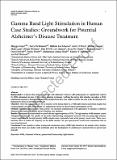Gamma band light stimulation in human case studies: Groundwork for potential Alzheimer's disease treatment
Date
2019-05-27Author
Jones, Marggie
McDermott, Barry
Oliveira, Bárbara Luz
O'Brien, Aoife
Coogan, Declan
Lang, Mark
Moriarty, Niamh
Dowd, Eilis
Quinlan, Leo
Mc Ginley, Brian
Dunne, Eoghan
Newell, David
Porter, Emily
Elahi, Muhammad Adnan
O' Halloran, Martin
Shahzad, Atif
Metadata
Show full item recordUsage
This item's downloads: 582 (view details)
Cited 13 times in Scopus (view citations)
Recommended Citation
Jones, Marggie, McDermott, Barry, Oliveira, Bárbara Luz, O'Brien, Aoife, Coogan, Declan, Lang, Mark, Moriarty, Niamh Dowd, Eilis,Quinlan, Leo, Mc Ginley, Brian, Dunne, Eoghan, Newell, David,Porter, Emily, Elahi, Muhammad Adnan O' Halloran, Martin, Shahzad, Atif. (2019). Gamma band light stimulation in human case studies: Groundwork for potential Alzheimer's disease treatment. Journal of Alzheimer's Disease, 1-15. doi: 10.3233/JAD-190299
Published Version
Abstract
It is known that proteins associated with Alzheimer's disease (AD) pathogenesis are significantly reduced by 40¿Hz entrainment in mice. If this were to translate to humans, verifying that such a light stimulus can induce a 40¿Hz entrainment response in humans and harnessing insights from these case studies could be one step in the development of a multisensory device to prevent and treat AD.
Verify the inducement of a 40¿Hz response in the human brain by a 40¿Hz light stimulus and obtain insights that could potentially aid in the development of a multisensory device for the prevention and treatment of AD.
Electroencephalographic brain activity was recorded simultaneously with application of stimulus at different frequencies and intensities. Power spectral densities were analyzed.
Entrainment to visual stimuli occurred with the largest response at 40¿Hz. The high intensity 40¿Hz stimulus caused widespread entrainment. The number of electrodes demonstrating entrainment increased with increasing light intensity. Largest amplitudes for the high intensity 40¿Hz stimulus were consistently found at the primary visual cortex. There was a harmonic effect at double the frequency for the 40¿Hz stimulus. An eyes-open protocol caused more entrainment than an eyes-closed protocol.
It was possible to induce widespread entrainment using a 40¿Hz light stimulus in this sample cohort. Insights gleaned from these case studies could potentially aid in the development of a multisensory medical device to prevent and treat AD.


